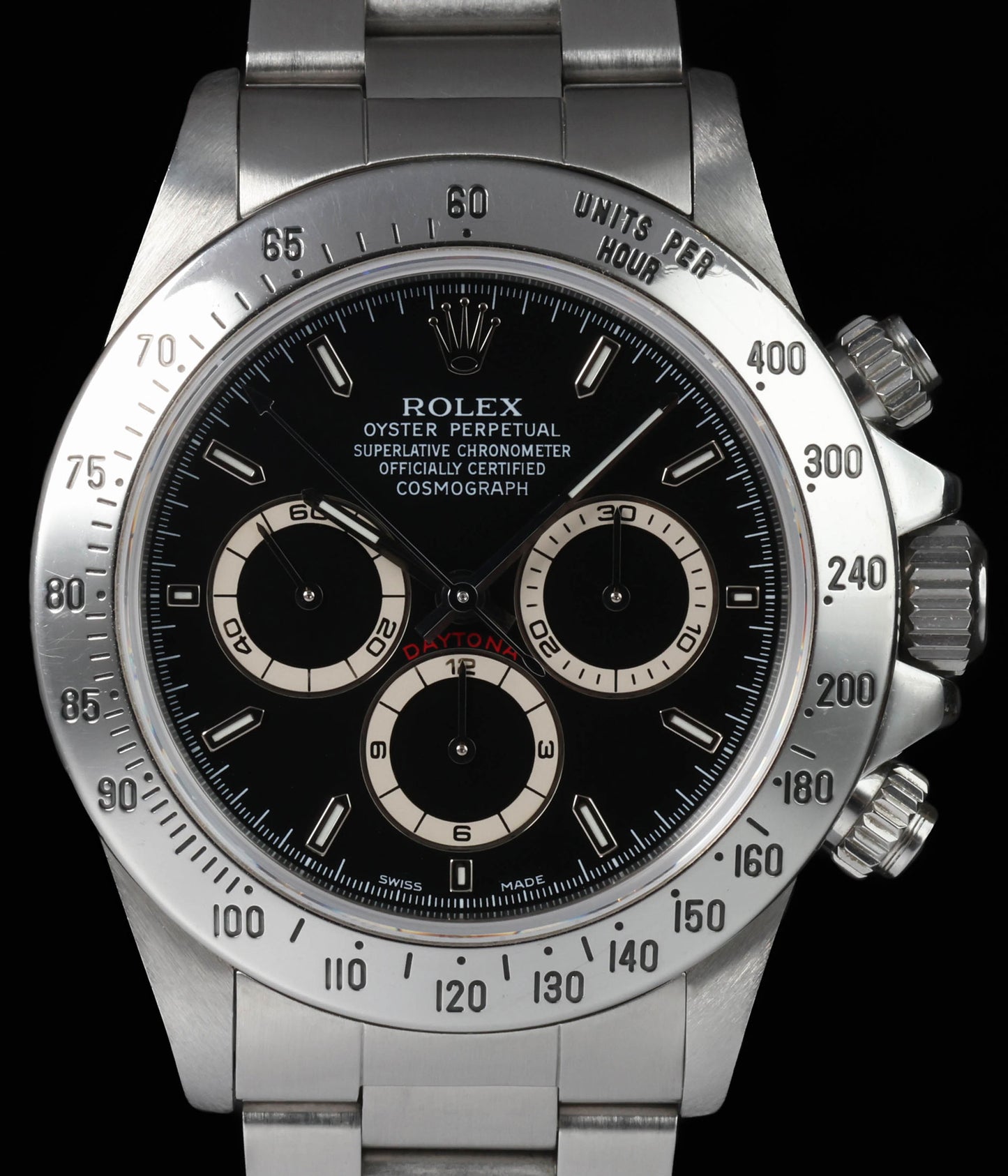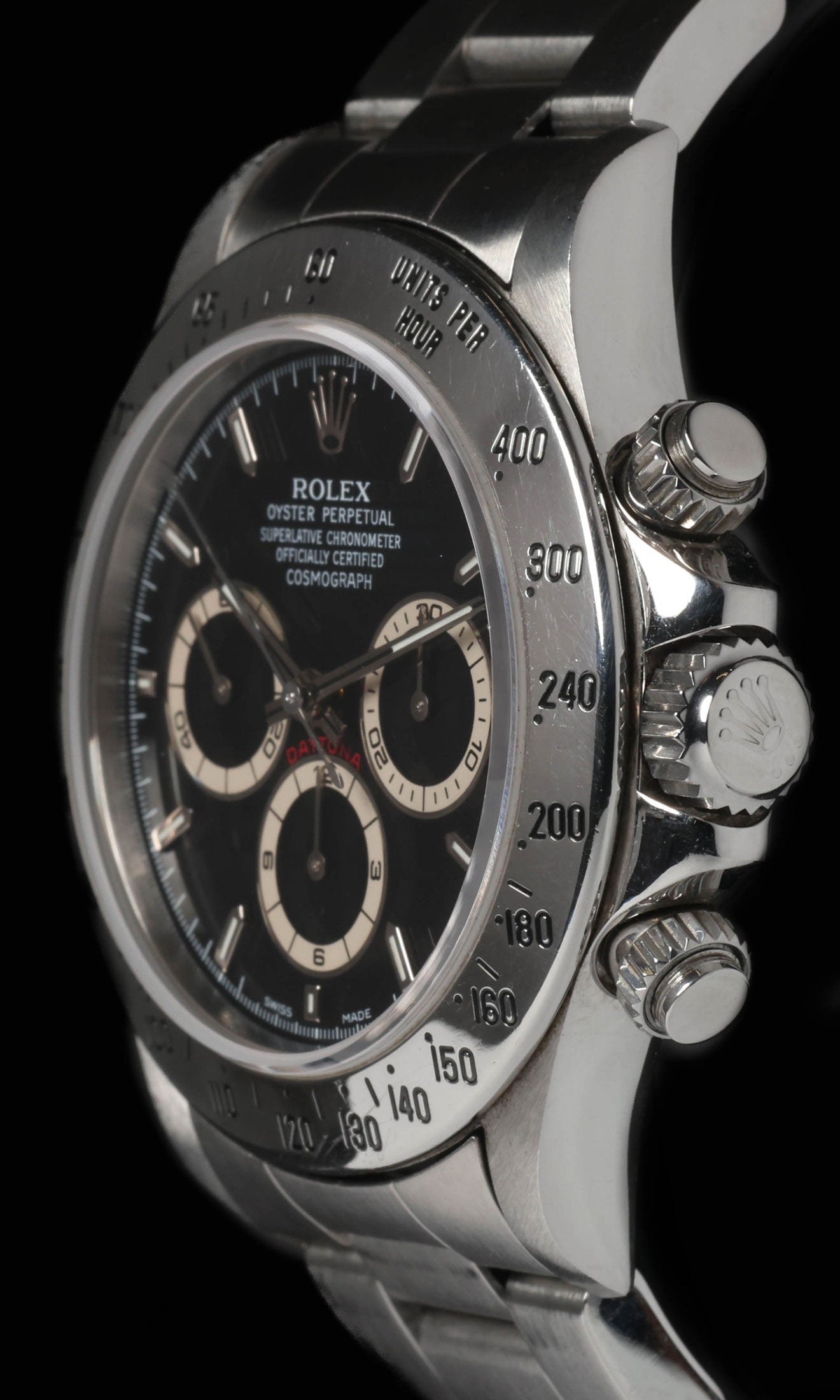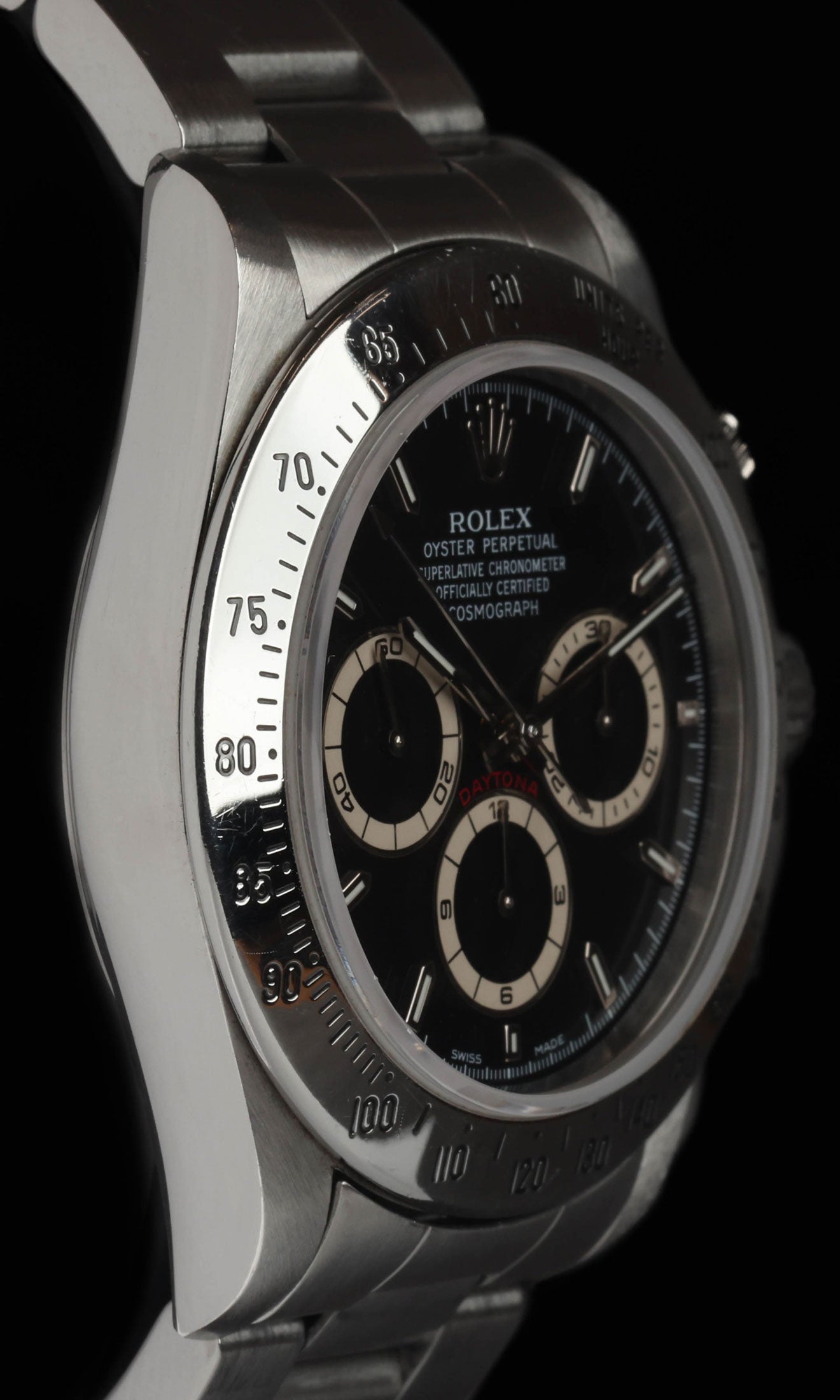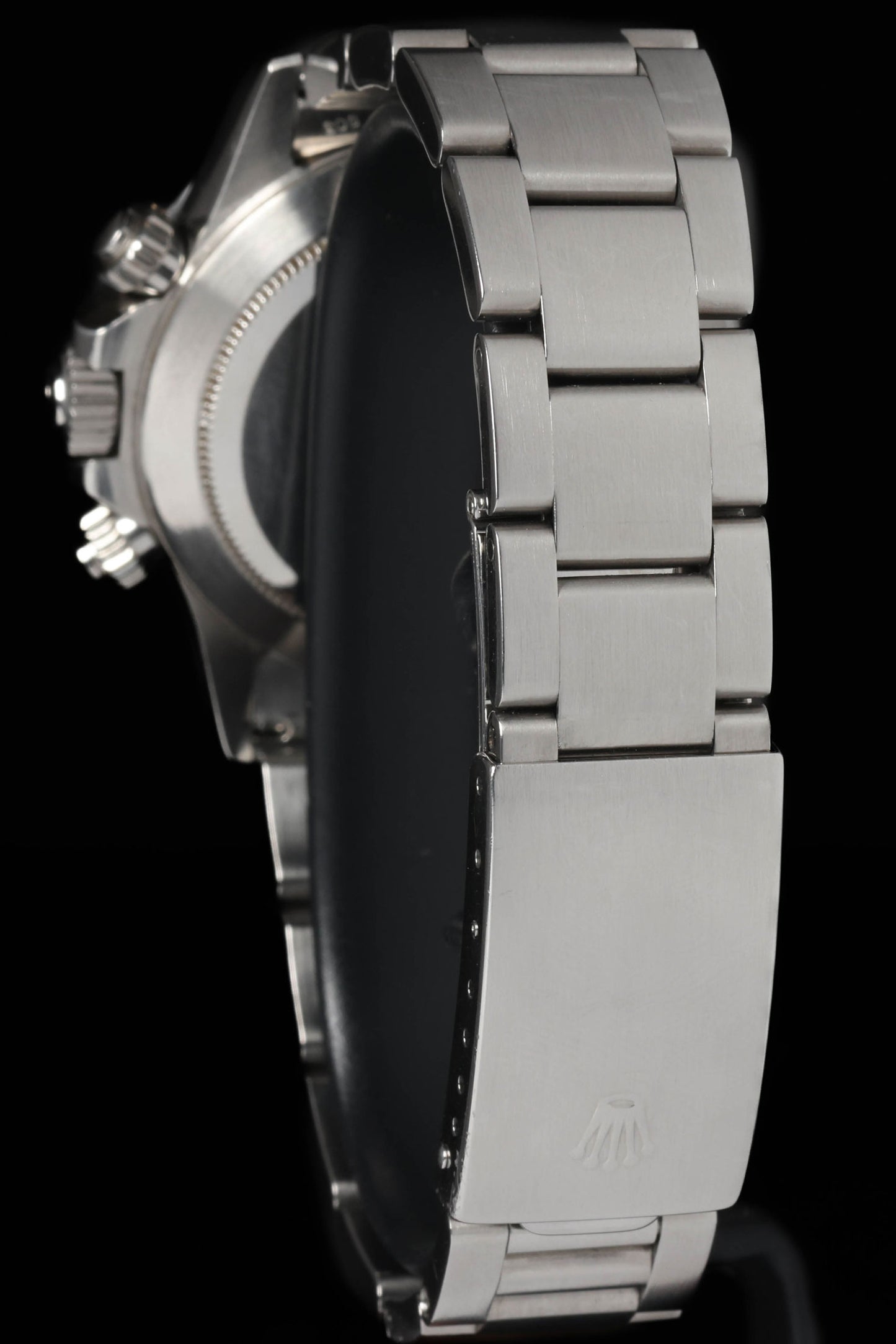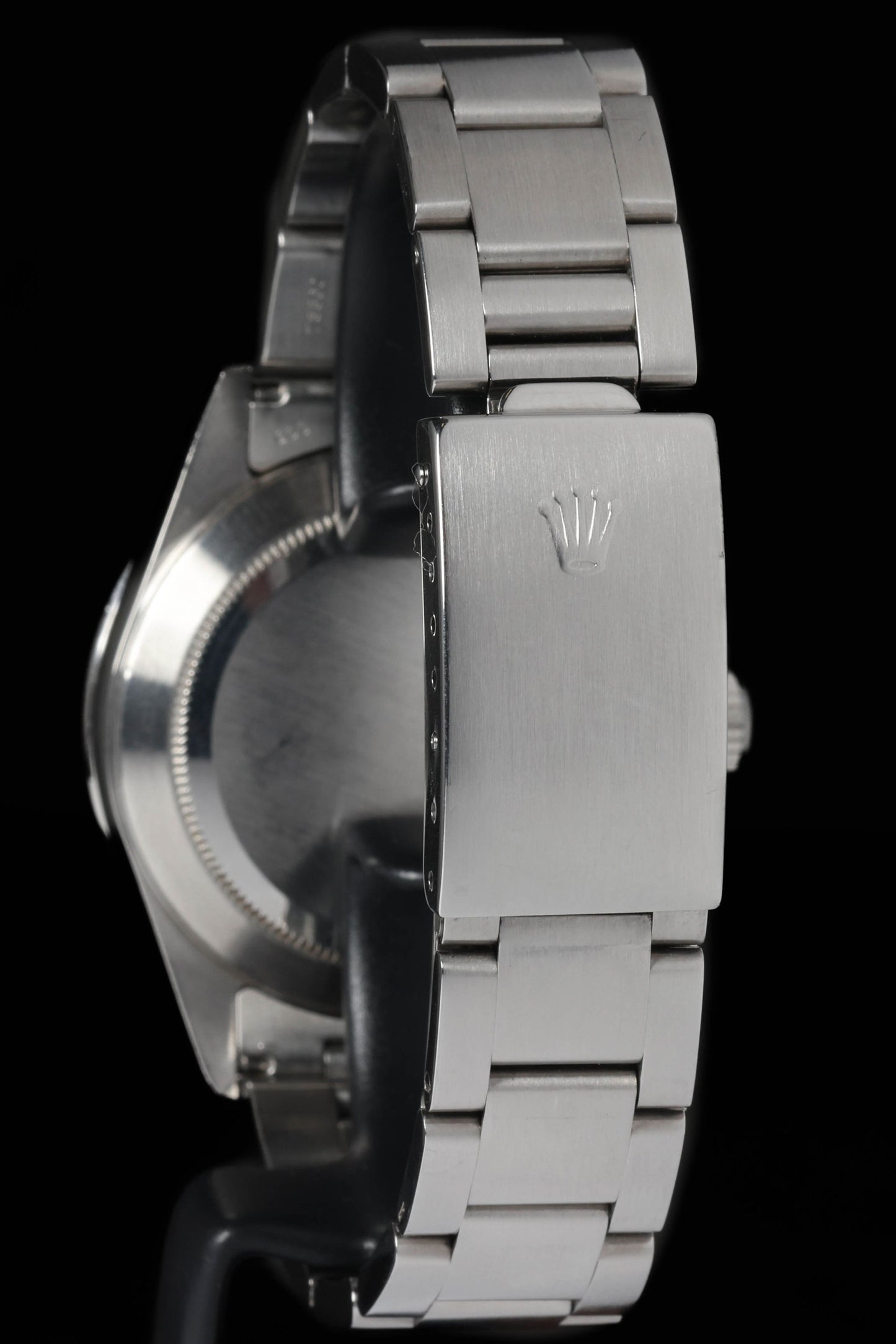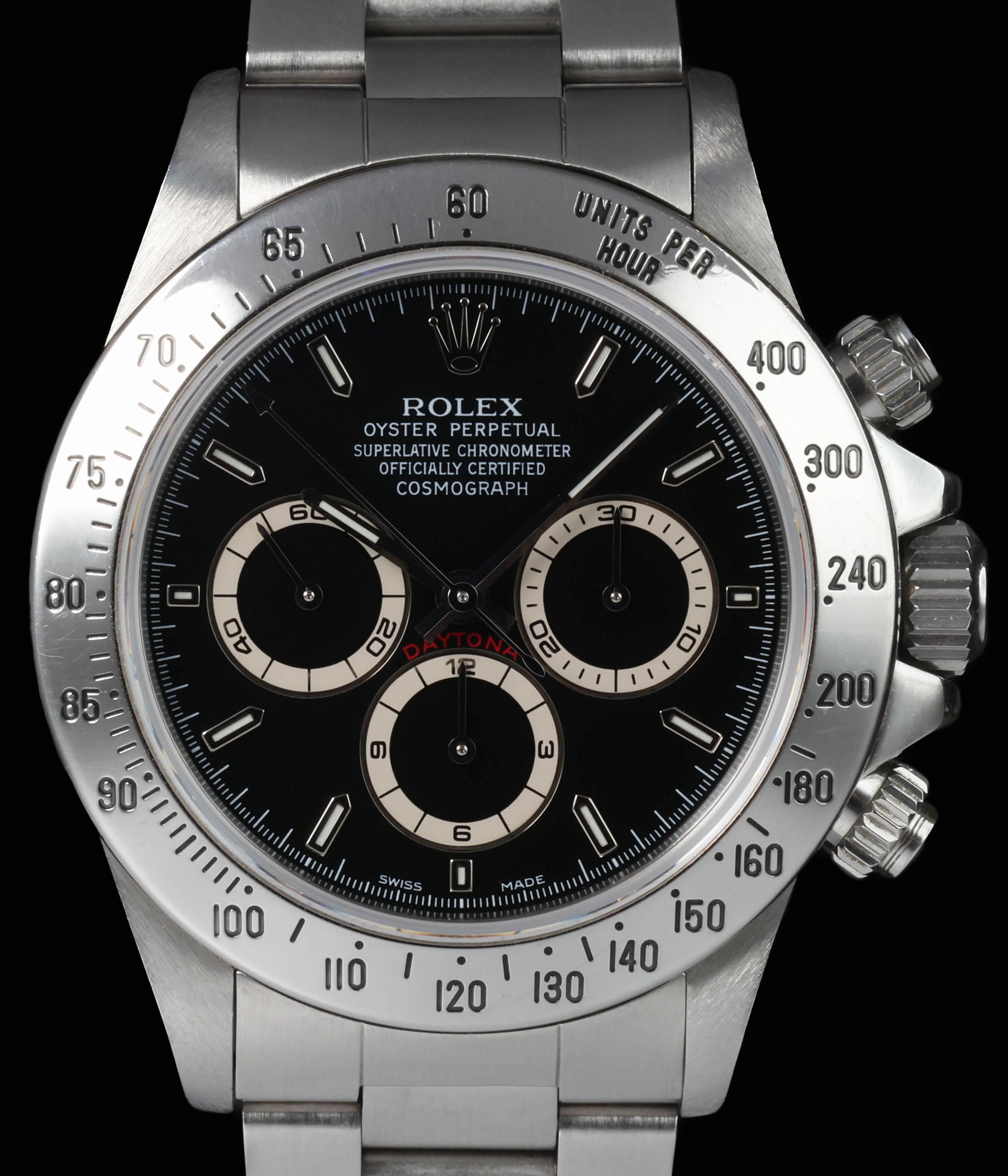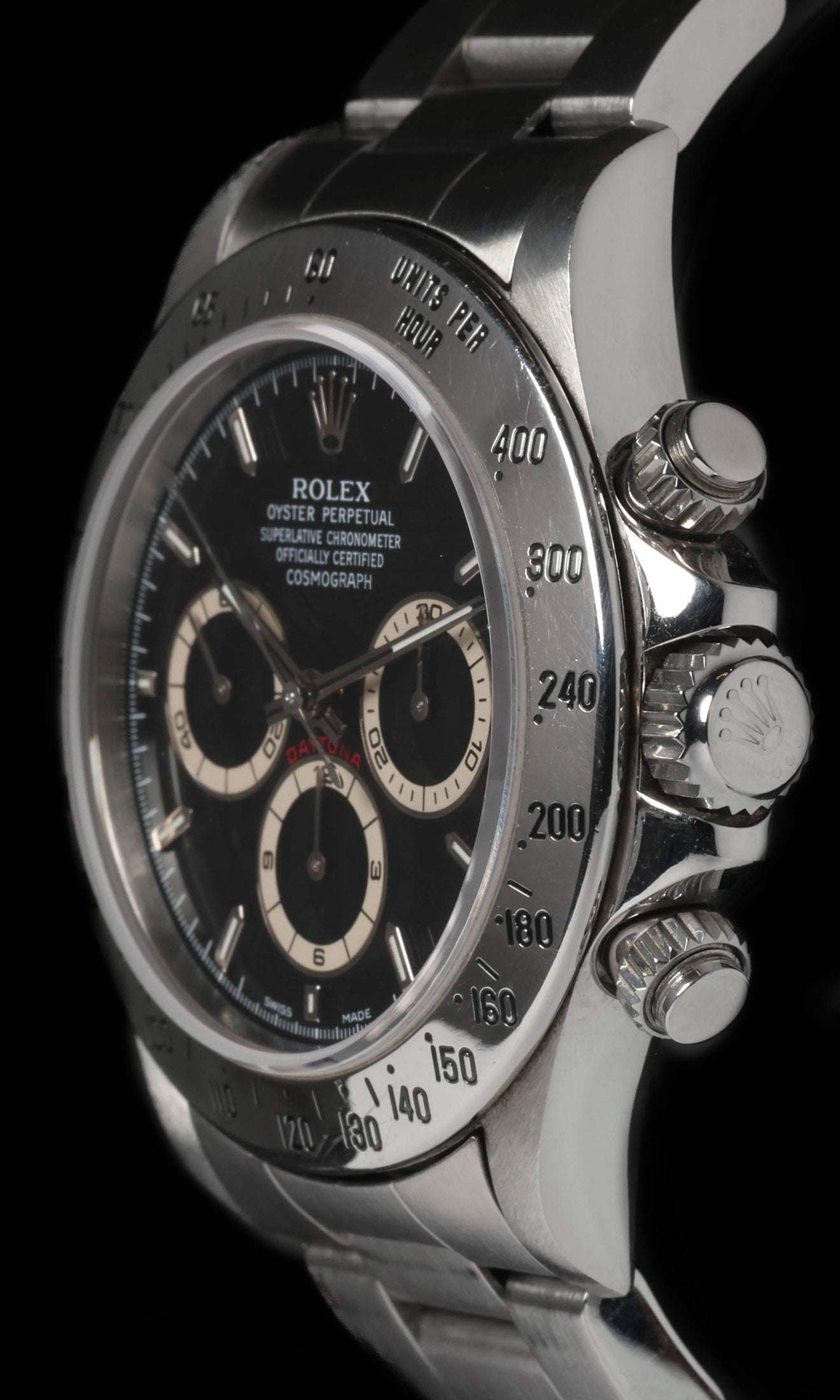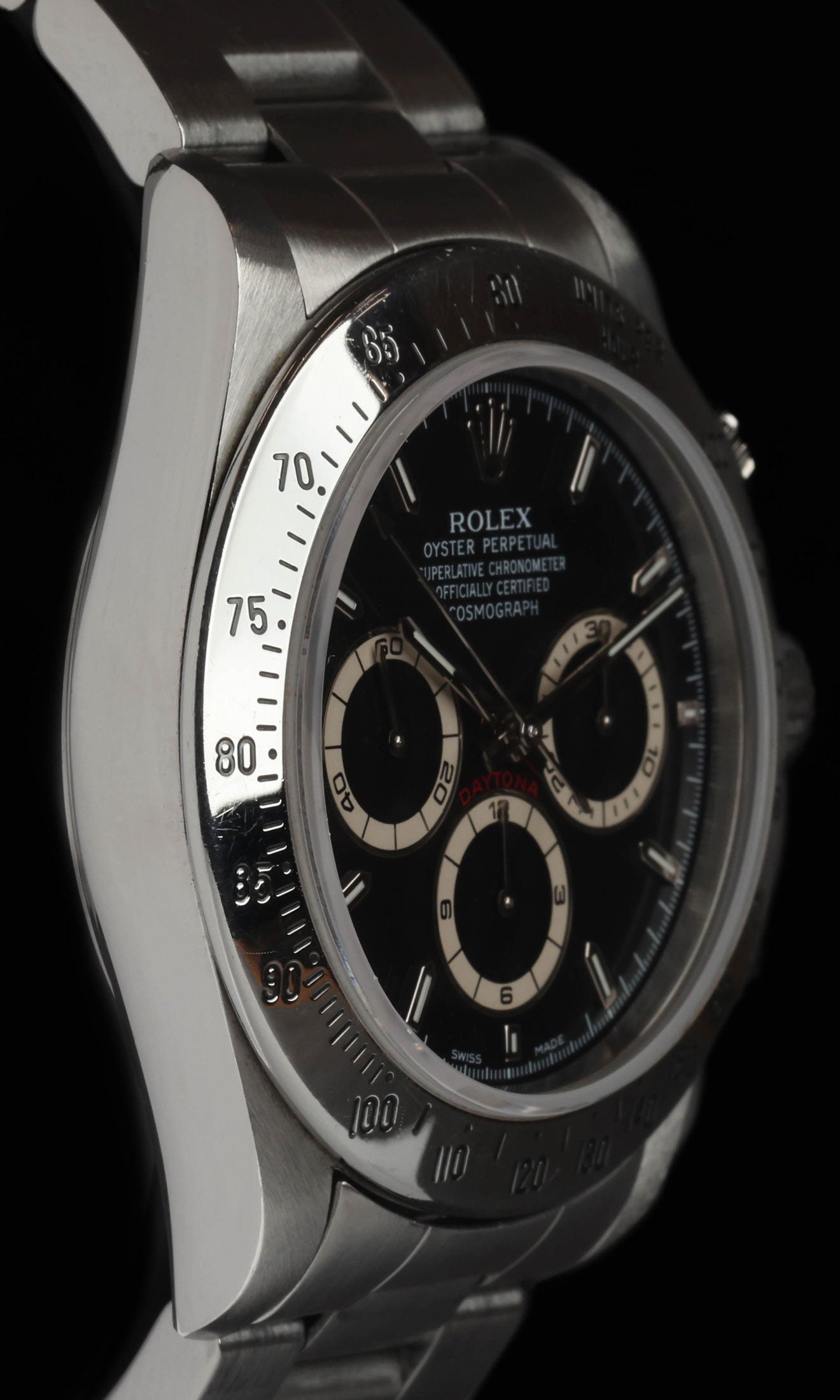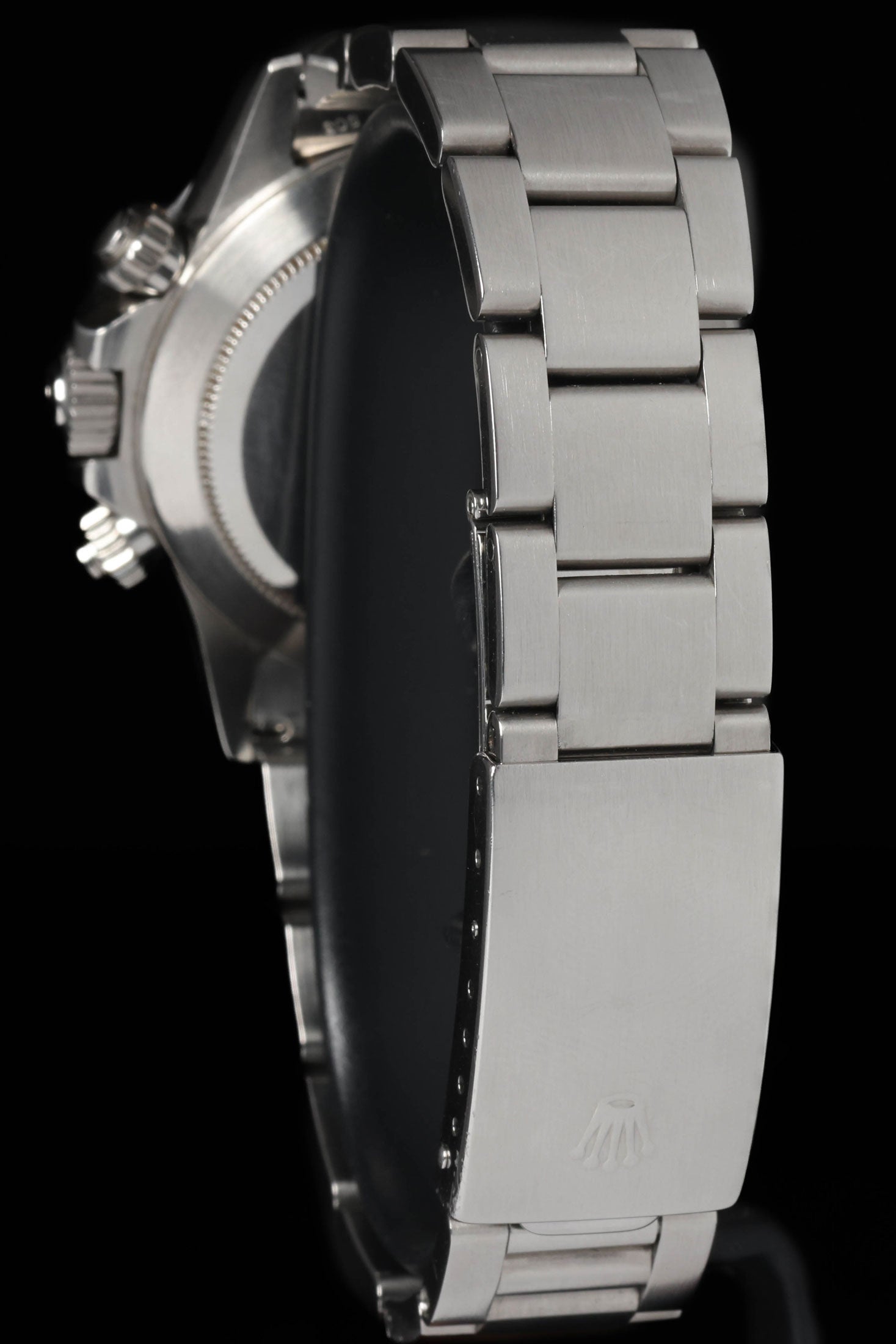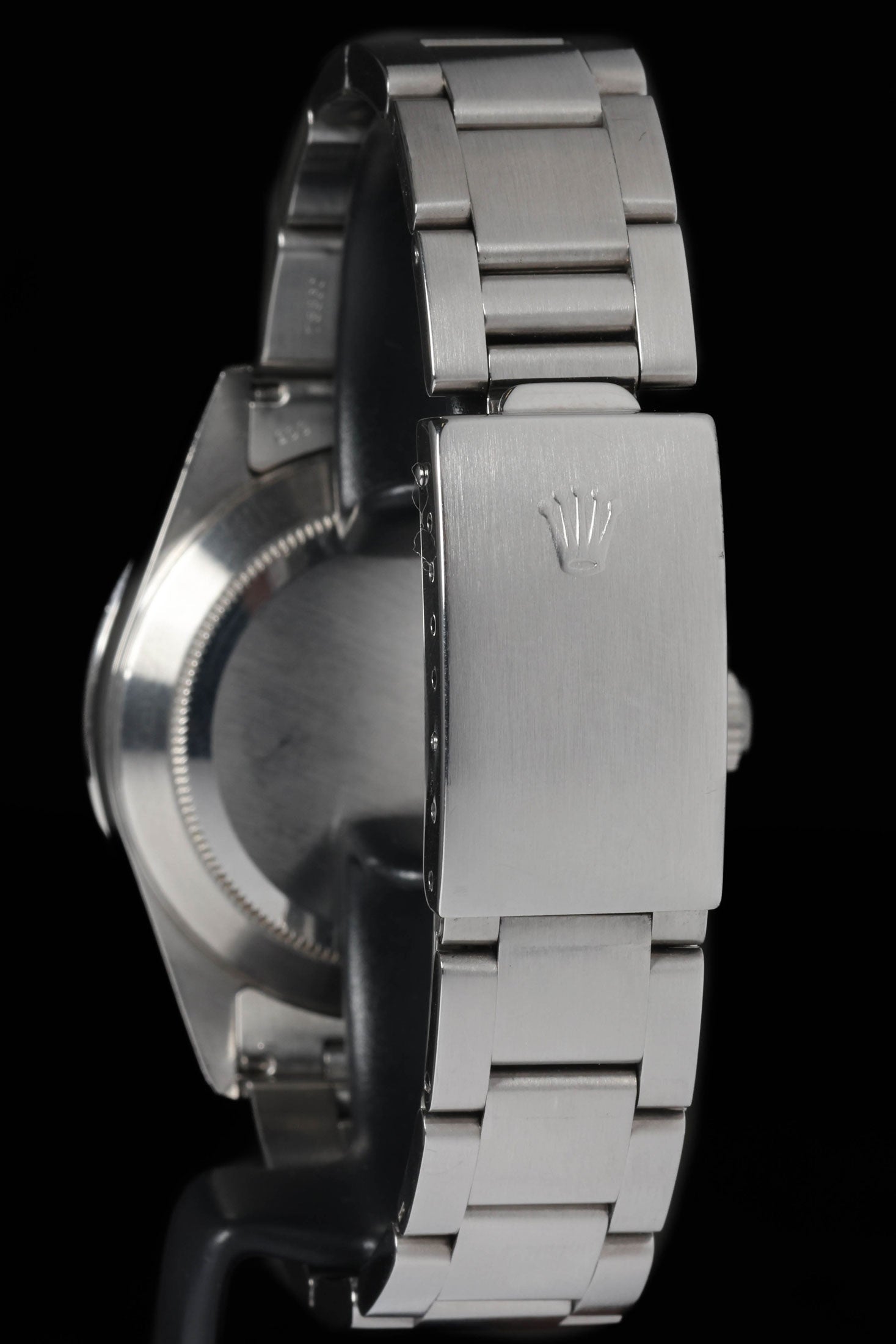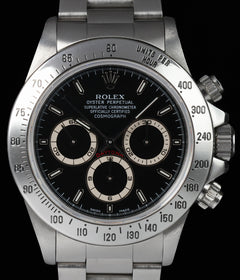Crown Vintage
Rolex Daytona Cosmograph 16520 'Zenith' 40mm 1991
Rolex Daytona Cosmograph 16520 'Zenith' 40mm 1991
Couldn't load pickup availability
Rolex Daytona Cosmograph 16520 'Zenith'
The stainless-steel case presents in very good condition with notably sharp lugs; original factory brushing remains clearly visible across the tops of the lugs and case flanks. Edge definition is strong with no evidence of heavy refinishing, and there are no dents or deep marks observed under angled light.
The bezel is in very good condition, showing clean, legible engravings and uniform surface tone with only light signs of careful wear.
All hour indices are intact with no paint loss or chipping; dial printing is crisp and even. The dial is a later service replacement and displays a very attractive, even patina that enhances legibility and visual balance. Hands are flawless, free of oxidation or spotting, with clean facets and correctly aligned tips.
An honest, well-preserved example in great condition—sharp lugs with original brushing, very good bezel, intact indices, flawless hands and a nicely patinated service dial.
Share
Why we love this watch
Why we love this watch
Rolex Daytona 16520 (1991): Zenith-Era Steel Chronograph That Modernised the Cosmograph
Introduction
The Rolex Cosmograph Daytona 16520 from 1991 marks the moment the famous racing timer became a true modern daily chronograph. A 40mm Oystersteel case, sapphire crystal, fixed steel tachymeter bezel and screw-down pushers deliver purpose and polish, while the Zenith-derived automatic calibre 4030 introduced convenience and consistency. With glossy black or bright white dials framed by contrasting sub-register rings and applied hour markers, the reference blends instrument clarity with restrained theatre. It is the bridge between hand-wound, acrylic-crystal Daytonas and the in-house era that followed—recognisably Daytona, yet ready for contemporary wear.
Historical Significance: How the 16520 Repositioned the Daytona
In the 1960s the Cosmograph Daytona was a compact, hand-wound tool built around Valjoux architecture, Plexiglas crystals and engraved tachymeter scales for timing average speed. By the late 1980s the brief had shifted. Buyers expected automatic winding, sapphire durability and higher daily robustness without sacrificing the track-born dial language. Rolex answered in 1988 with a new automatic line, and by 1991 the 16520 had established the look and feel of the modern steel Daytona: 40mm Oyster case, screw-down crown and pushers, 100-metre water resistance, polished steel tachymeter bezel to 400 units per hour, and crisp five-line chronometer text under the coronet. The reference proved a pivotal design reset. Proportions grew just enough for contemporary wrists, the sapphire crystal reduced glare and abrasion, and the applied batons with luminous plots delivered a cleaner night read. Importantly, the movement step—from manual to automatic—transformed the user experience, removing the daily winding ritual and encouraging constant wear. This combination of modern engineering with faithful design cues shaped the template that the in-house era would refine rather than reinvent.
Why the Zenith Era Matters
The 16520’s architecture codified the Daytona most people recognise today: tri-register layout, red “DAYTONA” script arcing over the 12-hour counter at six, contrasting sub-dial rings for readability, and a coherent steel-on-steel presentation. It is the reference that moved the Cosmograph from niche racing instrument to robust everyday chronograph while preserving the core identity.
Movement and Engineering: Calibre 4030 (Zenith-Derived)
At the heart of the 16520 is Rolex calibre 4030, derived from Zenith’s El Primero but extensively rebuilt to suit the Oyster mandate. The beat rate was reduced from 36,000 vph to 28,800 vph for broader lubricant tolerance and stability; the date mechanism was deleted; the escapement, balance and regulation were re-specified with a free-sprung balance and Microstella screws; and the winding system was revised for smooth, bi-directional efficiency. What emerges is a chronometer-rated automatic that prioritises amplitude consistency and predictable running in real-world conditions. The chronograph engages with a precise click; the reset to zero is crisp; and a practical power reserve of around 50 hours covers a day off the wrist with room to spare.
The Oyster Interface
Screw-down controls define the Daytona’s stance and function. The Triplock crown threads securely with positive stops; the pushers’ knurling is tall enough for easy grip; and, once tightened, the silhouette reads clean and aerodynamic. The 100-metre rating is not theatre—the case, crown and pusher system are built to keep the movement protected through active use on land or near water.
Case, Bezel and Crystal: Proportion with Purpose
The 40mm case wears slimmer than many modern chronographs, hovering near 12–12.5mm including crystal. Short lugs, brushed tops and polished case flanks manage visual weight so the head sits centred rather than perched. The fixed steel tachymeter bezel is deeply engraved from 60 to 400 units per hour, giving the watch an instrument edge without the glare of a high-polish insert. A flat sapphire crystal with a fine polished bevel controls reflections while preserving the classic Daytona top view.
Screw-Down Pushers and Tactility
Unscrewed, the start/stop pusher has firm resistance that encourages deliberate timing. The reset pusher returns all hands to zero without bounce. Screwed down, the pushers sit tidy and flush, reinforcing the watch’s disciplined geometry.
Dial and Hands: Reverse-Panda Drama, Instrument Discipline
A hallmark of the 16520 is dial contrast. On the black variant—like the watch pictured—the glossy base is punctuated by light silver sub-dial rings for a reverse-panda look that reads at distance. Applied baton markers with polished facets lift off the dial without generating distracting flare, and the slender central chronograph seconds hand reaches the rehaut for accurate indexing. Tritium lume (noted “T SWISS T<25” at six during this period) provides a modest, short-lived glow—appropriate for a chronograph that transitions from track to dinner with ease.
Early-Nineties Dial Traits
Dial text is balanced in five lines beneath the coronet; the red “DAYTONA” arcs neatly over the 6 o’clock register; and the sub-dial scales carry clear numerals without crowding. Subtle typographic shifts occurred across the early years—spacing, ring tone, letter shapes—yet the overall language stayed constant: glossy field, crisp printing, applied batons and legible tri-register symmetry.
Bracelet and Clasp: Oyster Confidence
The Oyster bracelet completes the case design in both function and feel. In this era non-SEL end links articulate cleanly at the lugs, aiding comfort and drape. Brushed outer links and polished centres echo the case finishing, adding just enough light play to avoid severity. The Oysterlock clasp closes with a positive snap and offers micro-adjust holes for a fine fit. Because the head is slim, weight distributes evenly across the wrist and the watch avoids top-heaviness.
Ergonomics in Daily Rotation
The step up from manual-wind vintage to the 16520 is immediately felt: automatic convenience, a slimmer profile under cuffs, and tactile controls that invite use. It is a chronograph you forget you’re wearing until you need it, then it performs on demand.
How It Works as a Timing Instrument
A tachymeter bezel plus long, clearly indexed chronograph seconds hand makes average-speed calculation straightforward over a known distance. The 30-minute counter at three o’clock is crisp at a glance; the 12-hour counter at six handles longer stints; and the running seconds at nine keeps you aware of the movement’s status. The layout is familiar for motorsport, but the same logic helps with ordinary intervals—brewing, training sets, commute checks—without feeling fussy.
Wearing Experience: Why the 16520 Still Feels Right
Proportion is the quiet triumph. At 40mm with short lugs and a restrained thickness, the 16520 wears compact yet assertive. The fixed steel bezel anchors the dial; the screw-down pushers balance the crown visually; and the Oyster bracelet’s taper keeps focus on the face. Monochrome tones—black and silver or white with black—pair easily with everything from denim to tailoring. It’s straightforward to live with, which is exactly the Daytona brief.
Evolution and Legacy: Setting the Stage for In-House
In 2000 Rolex introduced the calibre 4130 with a vertical clutch and column wheel, initiating the in-house era. Yet the design language barely shifted because the 16520 had already solved the big questions: case size, sapphire crystal, screw-down controls, steel tachymeter bezel, applied markers, tri-register dial and that discreet curve of red “DAYTONA”. The Zenith-era architecture proved an automatic Daytona could be robust, accurate and convenient while looking unequivocally like a Cosmograph.
What Endures in the Design
Look at any current steel Daytona and you can still trace the 16520’s blueprint: clean proportions, crisp tachymeter, applied batons, high-contrast sub-registers and compact pushers. The reference defined the modern silhouette, and later generations refined details without changing the essence.
The Watch in the Photo: Reverse-Panda Clarity
A black 16520 with silver sub-dial rings showcases what makes this reference so compelling. The laser-sharp steel bezel frames the dial without stealing attention; polished hands slice cleanly across the glossy field; and the red “DAYTONA” provides a restrained link to the model’s motor-sport heritage. On the wrist it reads as one coherent piece of equipment—case, bezel and bracelet working together to keep the chronograph tidy, balanced and legible.
Final Thoughts
The Rolex Daytona 16520 from 1991 is the steel chronograph that modernised the Cosmograph without abandoning its racing DNA. The Zenith-derived calibre 4030 brought dependable automatic timing; the 40mm Oyster case, sapphire crystal and screw-down controls delivered everyday robustness; and the dial design—applied batons, contrasting sub-registers and a discreet red “DAYTONA”—cemented the modern identity. It stands at a crossroads in the Daytona story, proving that a purpose-built instrument can evolve for contemporary life while staying true to its roots.
Case & Bracelet
Case & Bracelet
Case in very good condition. Very sharp lugs. Original factory brushing visible. Bezel in very good condition. All indices intact with no paint chipping.
Dial & Hands
Dial & Hands
Dial and hands flawless. Dial is a service dial with a very nice patina.
Warranty & Condition
Warranty & Condition
Crown Vintage Watches provides a minimum 3-month mechanical warranty on pre-owned watches, from the date of purchase.
The warranty covers mechanical defects only.
The warranty does not cover damages such as scratches, finish, crystals, glass, straps (leather, fabric or rubber damage due to wear and tear), damage resulting from wear under conditions exceeding the watch manufacturer’s water resistance limitations, and damage due to physical and or accidental abuse.
Please note, water resistance is neither tested nor guaranteed.
Shipping and insurance costs for warranty returns to us must be covered by the customer. Returns must be shipped via traceable courier. Return shipment must be pre-paid and fully insured. Collect shipping will be refused. In case of loss or damages, the customer is liable.
Our Pledge
At Crown Vintage Watches, we stand by the authenticity of every product we sell. For added peace of mind, customers are welcome to have items independently authenticated at their own expense.
Condition
Due to the nature of vintage timepieces, all watches are sold as is. We will accurately describe the current condition and working order of all watches we sell to the best of our ability.
Shipping & Refund
Shipping & Refund
